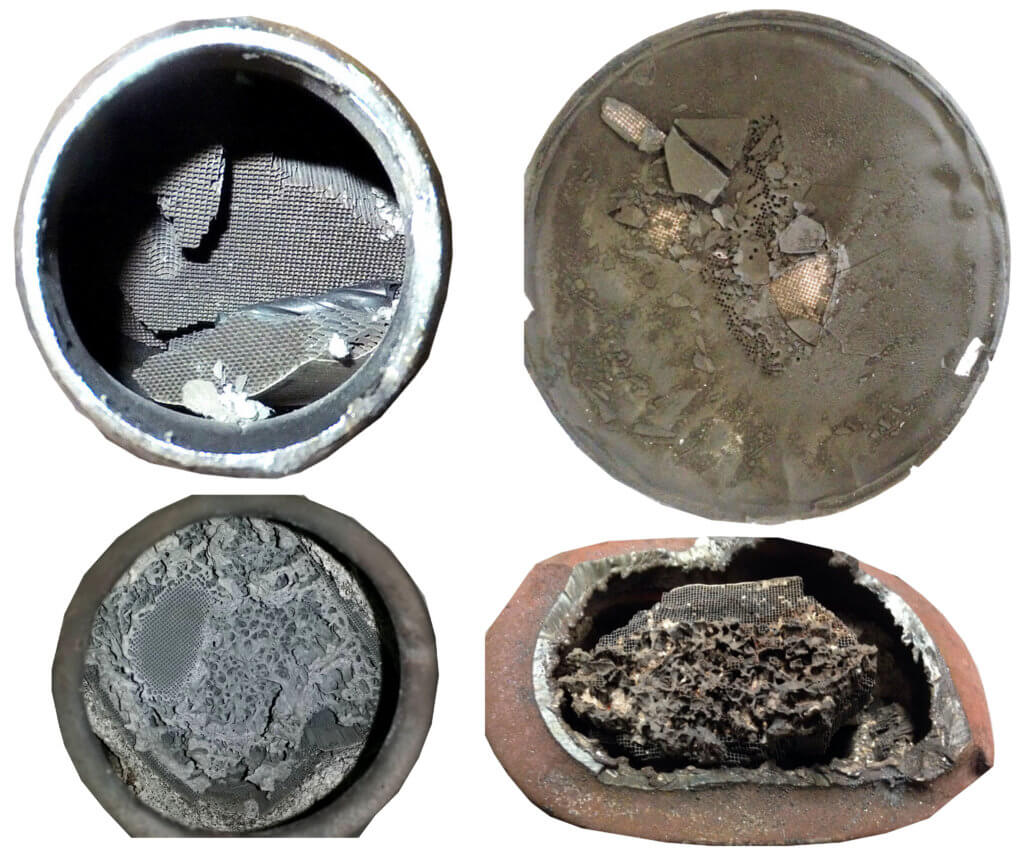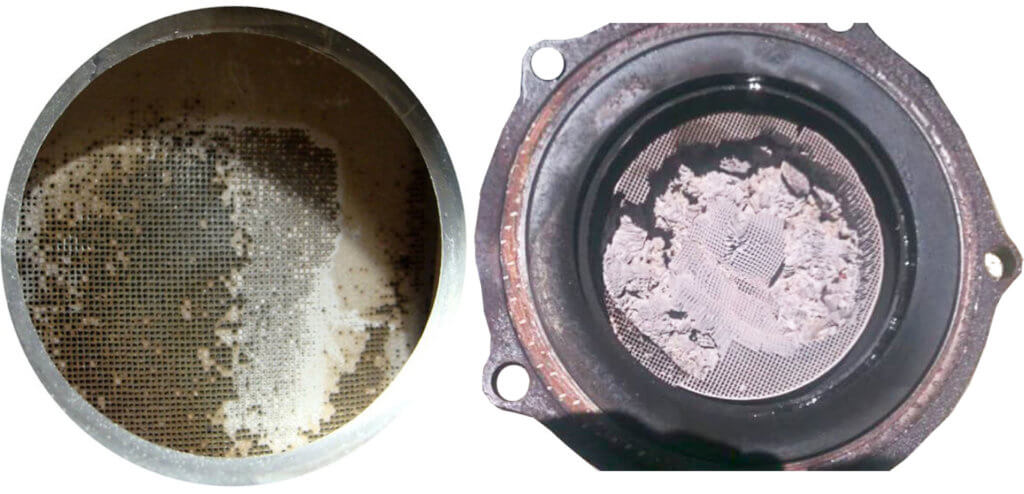Cataclean catalytic converter cleaner
Cataclean catalytic converter cleaner — does it work?
Four things can cause a catalytic converter to set a P0420 or P0430 trouble code: oil or carbon coating on the surface of the honeycomb, melted substrate caused by overheating, a poisoned substrate, and impact damage. Cataclean can only address one of those issues and even then, the fix is only temporary. Unless you’re prepared to fix the underlying problem that caused the catalytic converter to fail in the first place the P0420 or P0430 will return.
What causes a catalytic converter to set a P0420 pr P0430?
1) An 0il or carbon coating on the ceramic substrate will cause a catalytic converter failure code
Oil, soot and carbon buildup on the ceramic honeycomb prevents the exhaust gas from contacting the reactive metals in the catalytic converter.
• Worn piston rings cause oil to burn in the cylinder, releasing oily residue into the exhaust that coats the honeycomb.
• Poor air/fuel mixture that produces excessive amounts of soot (carbon) into the exhaust
Cataclean may be able to remove some of the oil, soot or carbon buildup from the catalytic converter. Keep in mind that the Cataclean liquid is burned in the combustion chamber and only the burned remains actually reach the converter.
However, if you don’t fix the underlying problem that caused the oil or carbon coating, the P0420 and P0430 will return.
2) A melted substrate will cause catalytic converter failure code
What causes a catalytic converter ceramic structure to melt?
• A worn O2 sensor can cause rich fuel mixtures that dump too much fuel into the exhaust. The extra fuel causes the catalytic converter to overheat and melt the ceramic structure.
• Poor fuel quality can cause misfires that dump too much unburned fuel into the exhaust, causing converter melt-down.
• Weak spark and ignition issues can also cause misfires that dump excessive amounts of fuel into the catalytic converter.
• A restricted air filter can cause rich fuel mixtures that send too much unburned fuel into the converter.
• Excessive engine load can cause the catalytic converter to overheat
• Low engine compression can cause incomplete combustion, resulting in unburned gas flow into the converter
Cataclean will NOT fix a melted ceramic substrate. It’s a complete waste of time and money to use any type of cleaner to fix a melted substrate.
3) A poisoned catalytic converter will cause a P0420 or P0430 trouble code
• Antifreeze in the exhaust will poison a catalytic converter. Antifreeze gets into the exhaust stream due to a head gasket or intake gasket leak.
• Leaded gasoline will poison a catalytic converter
• Oil additives that contain zinc (ZDDP) will poison a catalytic converter
• Non-converter friendly Silicone sealants will poison a catalytic converter
Cataclean will NOT fix a poisoned catalytic converter. It’s a complete waste of time and money to use any type of cleaner on a poisoned converter.
4) Impact damage will cause a catalytic converter to set a P0420 or P0430
If you run over a parking curb or hit a boulder and dent the outer shell of the converter, chances are high that you’ve also cracked/shattered the ceramic structure. No cleaner will fix that.
Cataclean will NOT fix an impact-damaged converter. It’s a complete waste of time and money to use any type of cleaner on a dented catalytic converter.
How cat converter cleaners supposedly work to remove soot
Some catalytic converter cleaner chemicals like Cataclean or CRC’s Guaranteed To Pass contain strong solvents like Xylene, Acetone, and 1-Propanol.
Cataclean formula (from their patent)
Kerosene about 8 parts by volume
Toluene about 12 parts by volume
Xylene about 40 parts by volume
Hexanol about 2 parts by volume
Isopropanol about18 parts by volume
Acetone about 20 parts by volume
The entire mixture should be added to the fuel in 32 parts to the fuel volume
During combustion, the solvents convert into carboxylic acid, active peroxy oxides, and aldehydes, In some cases, they can clean off the carbon coating. But that fix is only temporary
Just as a side note, unplugging an ignition coil and revving the engine to 2,000 RPM can cause a misfire that loads the cat converter with raw fuel. That raw fuel also washes off the soot and causes the cat converter temperature to rise high enough to burn off other carbon deposits.
CRC Guaranteed To Pass
The CRC Guaranteed To Pass cleaner takes a different approach than Cataclean. Their Material Safety and Data Sheet (MSDS) shows
Petroleum Distillate25-35%
Sweetened middle petroleum distillate 25-35%
Polyether amine (P.E.A.) (Proprietary_ 25-35%
Solvent naphtha <5
Naphthalene <1
P.E.A. is the most commonly used additive in Top Tier fuel to prevent fuel system deposits.

Nothing will fix these clogged and melted catalytic converters. they must be replaced
Catalytic converter myths
Can I Clean My Catalytic Converter With Soap and Water?
Perhaps temporarily. Removing the catalytic converter and soaking it in a degreaser solution may remove oil or carbon coatings, allowing the converter to function again. However, if you don’t fix the underlying problem that caused the oil or carbon to build up, the coating will just reform. In other words, even if the cleaning works for a short period, it won’t fix the underlying problem.
Can I Clean My Catalytic Converter With Lacquer Thinner or acetone?
No. Gasoline already contains Xylene, Acetone, and 1-Propanol. Adding more of those chemicals will only cause a cat converter meltdown and damage fuel system components.
©, 2021 Rick Muscoplat
Posted on by Rick Muscoplat
